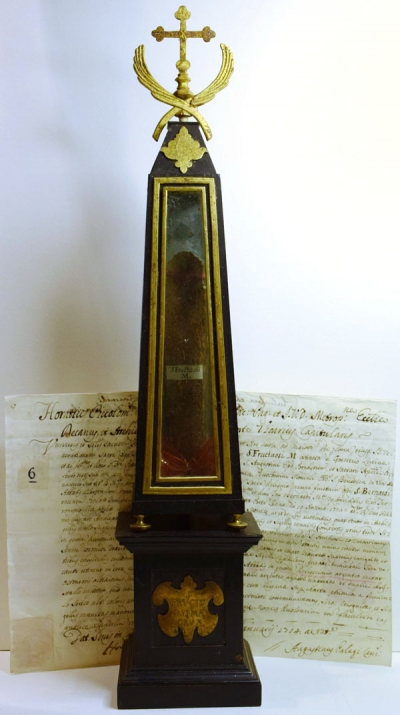The Holy Martyr Saint Fructuosus of Tarragona († 259) (also known as Saint Fructose) was the bishop of a large and oldest Christian community in Tarragona, a port city in Catalonia (Spain). The emperor of the Roman Empire Valerian (ruled 253-260 AD), in 258, began persecutions against Christians. Fructuosus and his deacons Augustus and Eulogius were arrested on January 16, 259 by order of the proconsul Emilian, who personally interrogated them. The investigation lasted less than a week and all sources note that the arrested people not only held with great courage, but also used the slightest opportunity to appeal to members of their community. Finally, on January 21, in the arena of Tarragona, the holy martyrs were executed by being burned at the stake. After the execution, the remains of the martyrs were collected by Christians. Fearing persecution, some members of the community took the relics of the martyrs to Liguria (the seacoast in northern Italy), where in due course they founded the abbey of San Fruttozo (the modern city of Capodimonte), where the relics of Saint Fructuosus were stored. Fearing the pirates' attacks, part of the holy relics of the saint were moved further inland - to the city of Siena (Tuscany). The saint's day is celebrated on the day of martyrdom - on January 21.
Reliquary in the form of a tall obelisk of veneered ebony wood with front and side glass windows, standing on a rectangular base and topped with a gilt brass finial in the form of a cross and crossed palm branches, traditionally denoting a holy martyr. Inside the reliquary contains a historically significant relic of the ex ossibus (from the bone) from partem cruris (part of the leg) of the early Christian martyr Saint Fructuosus of Tarragona,positioned vertically and identified on a manuscript cedula label. On the back, the reliquary is sealed by a double impression in red Spanish waxof a seal of the Siena cathedral.The reliquary is accompanied by the original certification document issued and hand-signed in 1714 by fr. Horatius Piccolomini Arragona, interim Archbishop of Siena. The document describes the relic in Latin as follows:
"To each and all we pledge our good faith, and we testify that today, for the greater glory of God and the veneration of his saints, this holy reliquary of Martyr in Christ is declared to be part of the leg of Saint Fructuosus Martyr, dug up from the Lucina Cemetery of the Holy Family in Rome by brother Pierre Lambert Ledrou, († 1721), Order of Hermits of Saint Augustine, Bishop of Porphyrion [1692 - 1721] and the Prefect of the Apostolic Shrine in the days leading up to 24 July 1701. Given as a gift to Mother Superior Maria Monica Viciolomini, of the Convent of the Holy Family of the order of St. Benedict in the venerable monastery of the Blessed Virgin Mary of this town of Tressa [present name Ponte a Tressa]."
Additional Info
- ID#: 182-RSCR-135
- Size: 19 1/4 in (49 cm) high
- Age: ca. 1714
- Origin: Siena, Italy
- Materials: Wood, glass
- Price: SOLD!
-

Additional Images of this Item
https://www.russianstore.com/en/online-store/catholic-reliquaries/item/1340-18th-century-reliquary-with-xlarge-relic-of-saint-fructuosis-martyr#sigProId30ada3abe8
Online Store & Services
Information
Quick Link
Information
Quick Link
SAVE 5% from your first purchase when you subscribe to receive our infrequent mailings with updates on new arrivals, exclusive offers, and fascinating stories on relevant subjects.








 Поменять язык на русский
Поменять язык на русский 